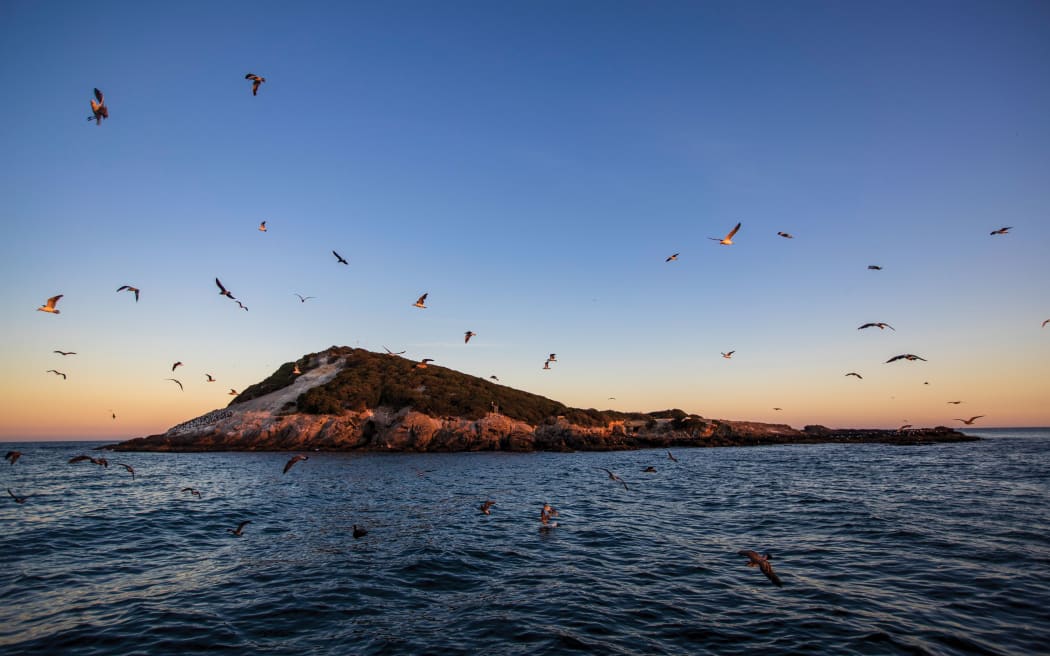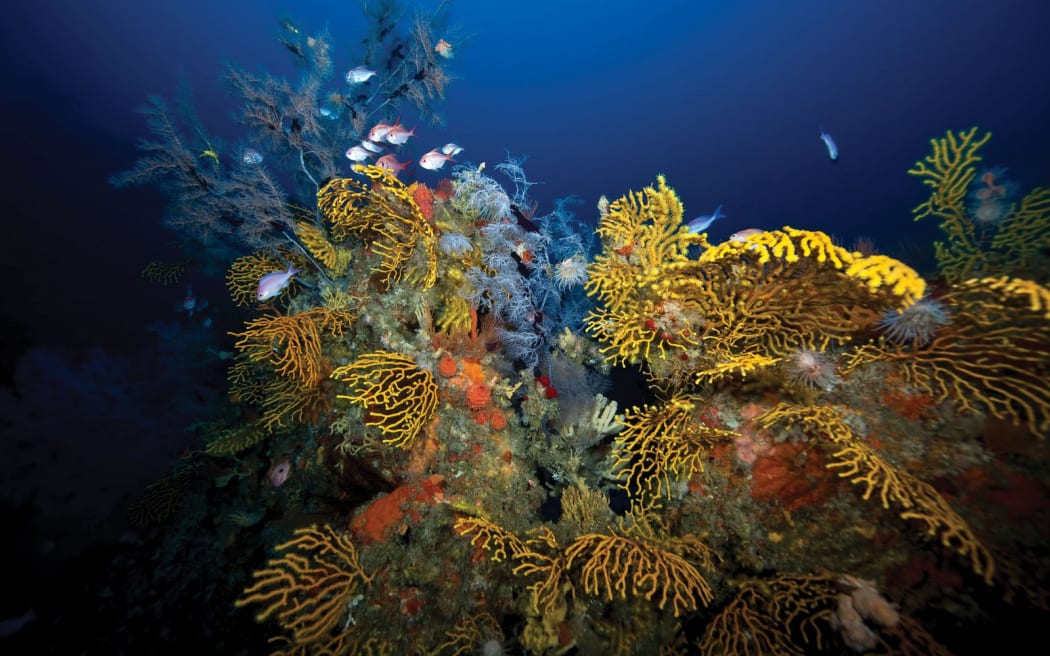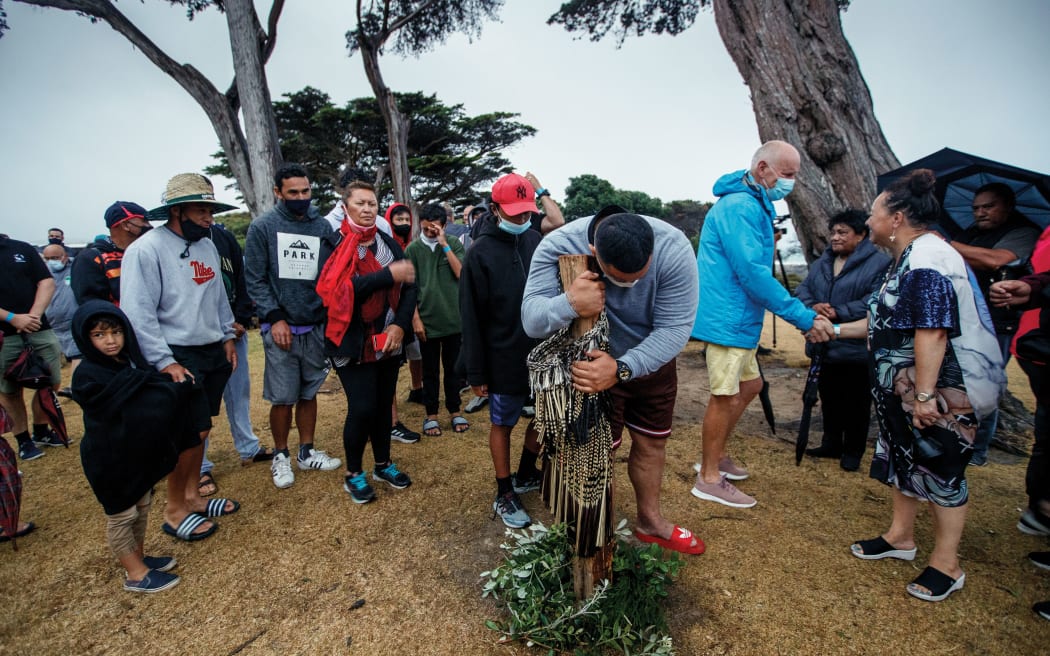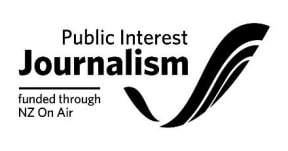
Green Island would be the jewel in the crown of a network of proposed marine reserves in Otago. Photo: © Richard Robinson
Follow Our Changing World on Apple Podcasts, Spotify, iHeartRADIO or wherever you listen to your podcasts
This is an updated excerpt from the July – August 2023 New Zealand Geographic feature article ‘Taking on water’.
In 1975 five square kilometres from Cape Rodney to Okakari Point was made a marine reserve, the first in New Zealand, and possibly, the world.
“Nothing to do at Goat Island anymore,” declared the local newspaper.
Three hundred thousand people now visit every year. And research indicates that this small, protected patch is helping to contribute fish to surrounding areas.
Lunching on experiments
The Marine Reserves Act was created in 1971 in response to campaigning by the late Bill Ballantine, among others. He was director of the University of Auckland’s Leigh Marine Laboratory which was established in 1964. But staff and students soon discovered people were eating their experiments.
So that’s what the Act was created for: ‘the purpose of preserving, as marine reserves for the scientific study of marine life, areas of New Zealand that contain underwater scenery, natural features, or marine life, of such distinctive quality, or so typical, or beautiful, or unique, that their continued preservation is in the national interest.’
Today, with our ocean ecosystems under increasing pressure from commercial and recreational fishing, sedimentation, pollution, and warming, we need our marine protection to do more than preserve small areas for scientific study.
But it’s not an easy task. Most marine protection proposals face extensive push back that delays the process for years, sometimes decades.
“It’s really, really hard to manage it appropriately,” says Professor Chris Hepburn, marine scientist at the University of Otago. “It’s land, sea. It’s different user groups, it’s rights, it’s things like the settlement, it’s people not understanding each other’s points of view.”
The act that ignored the Treaty
‘The settlement’ is the Treaty of Waitangi (Fisheries Claims) Settlement Act 1992, an attempt to restore some of the rights taken from Māori when it comes to fisheries.
Article II of the Treaty guarantees Māori ‘full, exclusive and undisturbed possession of their…fisheries’. Yet the Marine Reserves Act 1971 does not mention the Treaty of Waitangi once. And in 1986 the Quota Management System removed any recognition of Māori customary rights to fishing and fisheries, and commercial Māori fishers received disproportionately small amounts of quota.
The Quota Management System is how New Zealand manages most of the species important to commercial, recreational and customary fishers. There’s an annual limit of how much of each species can be caught, which is the total allowable catch. Part of this is set aside for recreational and customary fishing, and the rest is the total allowable commercial catch. Owning quota gives you the right to a proportion of that catch, and it can be bought, sold, and leased.
And so, following the establishment of the Quota Management System, six years of tense discussions led to the 1992 Māori Fisheries Settlement.
Māori received $150 million to buy half of Sealord, the ability to manage their own customary fisheries, and established the advocacy and settlement-protection entity now known as Te Ohu Kaimoana. Iwi also received 10 percent of existing quota, and the right to 20 percent of any new species brought into the Quota Management System.
In return, Māori gave up their right to any further fisheries claims.
This means that creating new marine reserves – no-take areas that lock away parts of the ocean forever – essentially tramples on these rights established by the 1992 settlement.
For tangata tiaki Brendan Flack, chair of the East Otago Taiāpure committee, it’s not just about fishing rights. “To me it’s about mātauranga. If you lock up anything, or you don’t have access to it, you lose the mātauranga,” he says.
Flack, and Ngāi Tahu customary leader Edward Ellison, have been part of the lengthy discussions around the establishment of six new marine reserves for the south east of the South Island that will come into force this year under the Marine Reserve Act. But they view them as imperfect measures. As Ellison said on the day of the announcement: “We came together on this process because we thought it would work, it did work, and our commitment was to follow that through, and to have these reserves introduced…. We won’t do that again under the current legislation.”

This reef in the Poor Knights Islands Marine Reserve was named Wade’s World, in homage to the late diver and naturalist Wade Doak. Photo: © Richard Robinson
The patchwork of New Zealand marine protection
New Zealand looks after its vast ocean area using a range of approaches – fisheries management, marine reserves, other types of marine protection areas and marine protection tools such as marine mammal sanctuaries, benthic protection areas and customary reserves.
Because the Marine Reserves Act 1971 is restrictive, only applies to our territorial sea, and doesn’t mention the Treaty, recently there have been efforts to establish new, bespoke, types of marine protection that do consider Māori rights and te ao Māori, or enable protection in our vast exclusive economic zone (EEZ). A 2015 Ministry for the Environment consultation document outlined the need for a new Marine Protected Areas Act to replace the Marine Reserves Act 1971, but as yet it hasn’t happened.
New Zealand’s EEZ covers an area of more than 4 million square kilometers, the fourth largest in the world, and we currently protect (to marine protection area standard) less than 0.5% of it. In our territorial sea (out to 12 nautical miles) we protect just under 12%, and most of this is in two offshore marine reserves: the Kermadecs Marine Reserve and Auckland Islands Marine Reserve.
Starting in 2015, politicians, public servants and iwi hashed out the Kermadecs Ocean Sanctuary Bill, designed to protect 620,000 square kilometers around the Kermadec Islands. This would have bumped that EEZ protection up by 15%, a big step towards achieving the protection of 30% of our ocean by 2030 that New Zealand committed to in December 2022.
But mid 2023 iwi organisations voted against supporting the final version, and Oceans and Fisheries Minister Shane Jones announced late March 2024 that the Bill will be withdrawn.
Another bespoke work-around is the Hauraki Gulf / Tīkapa Moana Marine Protection Bill, aimed at addressing the well-documented decline of the Gulf. It sets out the establishment of 19 new marine protection areas: two marine reserve extensions, five seafloor protection areas, and 12 high protection areas (HPAs). The seafloor protection and high protection areas are new types of marine protection. The HPAs are no-take areas that also allow for the customary practices of tangata whenua.
The bill is currently at select committee stage after public submissions closed on 1 November 2023 (for transparency, the New Zealand Geographic publisher submitted in support of this bill). It’s not clear yet whether it will make it across the line.

Rehua Ferris embraces a pou marking a rāhui tapū at dawn on Waitangi Day 2022 in Tāwharanui Regional Park north of Auckland. Ngāti Manuhiri laid down the rāhui to allow scallops and other kaimoana to replenish in several sites in the Hauraki Gulf. Photo: © Richard Robinson
But what about the fish?
So far, we’ve talked history and politics, we’ve mentioned quotas, rights, customs, acts, legislation and bills.
But what about the sea creatures? What happens when you lock away a piece of the ocean, and don’t let anyone fish there?
The short answer is, if the reserve is well designed, and in the right place, then it’s really positive – for fish, for ecosystems, and even for economics. Marine reserves can be biodiversity hotspots and fish factories that stock surrounding areas, they can attract large numbers of tourists, and they can show us what once was, or what could be.
But none of this matters if we can’t figure out a way to talk to each other, and to work together.
Learn more:
- Read the New Zealand Geographic article by Kate Evans, with photography by Richard Robinson.
- One of the new High Protection Areas proposed for the Hauraki Gulf is around The Noises Islands, which Our Changing World travelled to early in 2023.
- To learn more about the Kermadec Ocean Sanctuary, listen to this episode of The Detail from June 2023.
- Listen to previous episodes of Voice of Tangaroa.

Photo: NZ On Air
Voice of Tangaroa is a joint production between RNZ’s Our Changing World and New Zealand Geographic.
Reporting for this series is Public Interest Journalism funded through NZ On Air. You can learn more and read the articles for free at www.nzgeo.com/seas

